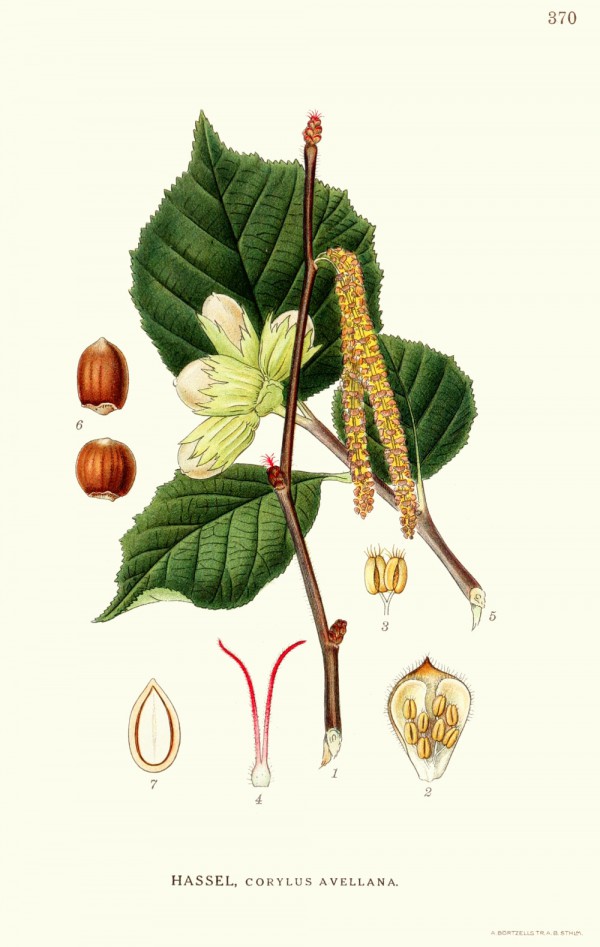Dies ist eine alte Version des Dokuments!
Corylus avellana L. - Betulaceae - hazelnut, filbert, (European) hazel, Haselnuß, Haselstrauch
Deciduous shrub, broadly spreading, up to 5m tall, native to Europe, West Asia, cultivated elsewhere; leaves broadly ovate to broadly elliptic; staminate catkins lateral along branchlets, in clusters of 2-4; nuts bracts much enlarged, shorter than to only slightly longer than nuts.
http://www.efloras.org/florataxon.aspx?flora_id=1&taxon_id=233500449
„Common hazel is cultivated for its nuts in commercial orchards in Europe, Turkey, Iran and Caucasus. The name „hazelnut“ applies to the nuts of any of the species of the genus Corylus. This hazelnut or cobnut, the kernel of the seed, is edible and used raw or roasted, or ground into a paste.“ http://en.wikipedia.org/wiki/Corylus_avellana
Three-quarters of the world's commercially available „hazelnuts“ are produced in the Turkish Black Sea region. These are filberts, Corylus maxima, which are more sensitive to cold than C.avellana. http://de.wikipedia.org/wiki/Lambertshasel
„Potent odorants in commercially processed peanut, hazelnut, and pumpkin seed oils were evaluated by the application of aroma extract dilution analysis (AEDA) and gas chromatography-olfactometry of headspace samples (GCOH). AEDA revealed 38, 28 and 27 odour-active compounds in peanut, hazelnut, and pumpkin seed oils, respectively. Fifteen odorants were present in all oils; two of them showed the highest flavour dilution factor (FD-factor): 2-ethyl-3,5-dimethylpyrazine and 2,3-diethyl-5-methylpyrazine. Application of GCOH led to the identification of 21, 24, and 24 odorants in peanut, hazelnut, and pumpkin seed oils, respectively. Nine of them were found in all oils: acetaldehyde, propanal, 2-methylpropanal, 2- and 3-methylbutanal, 2-ethyl-3,5-dimethylpyrazine, 2,3-diethyl-5-methylpyrazine, (E)-2-nonenal and vanillin. The following odorants appeared with relative high FD-factors in the headspace of a single oil: 1-penten-3-one in peanut, 5-methyl-(E)-2-hepten-4-one (filbertone) in hazelnut, (Z)-4-heptenal and 3-ethyl-2,5-dimethylpyrazine in pumpkin seed oil.“
[A comparative study of potent odorants in peanut, hazelnut, and pumpkin seed oils on the basis of aroma extract dilution analysis (AEDA) and gas chromatography‐olfactometry of headspace samples (GCOH)., Matsui, T., Guth, H., & Grosch, W., Lipid/Fett, Vol.100(2), 1998, 51-56]
„The distribution of potent odorants in the four Italian (i.e., Romana, Giffoni, Mortarella, Piemonte), standard roasted hazelnut samples is visualized in the histogram of Fig. 4. This profiling confirms the perceivable differences of the overall sensory impact provided by roasted samples of different origin. In
particular: 2- and 3-methyl butanal and 2,3-pentanedione concur to define the characteristic malty and buttery notes; 5-methyl-4-heptanone, 5-methyl-(Z)-2-hepten-4-one and 5-methyl-(E)-2-hepten-4-one (filbertone) are responsible for the fruity and nutty sensation; hexanal and octanal are perceived as green and fatty, respectively, while secondary lipid-peroxidation products such as (E)-2-heptenal, (E)-2-octenal, (E)-2-nonenal, (E)-2-decenal, (E,E)-2,4-decadienal provide fatty sensations. The sweet and caramel like note
can be ascribed to the presence of 4-hydroxy-2,5-dimethyl-3(2H)-furanone, while phenylacetaldehyde and 2-phenylethanol elicit flowery and honey-like sensations. The highly variable abundance of some markers (e.g.,2-and3-methylbutanal, hexanal, octanal, nonanal and acetic acid is extremely informative of this aroma profiling assessment and provides a further valuable interpretation key for sample discrimination.“
[Profiling food volatiles by comprehensive two-dimensional ga schromatography coupled with mass spectrometry: Advanced fingerprinting approaches for comparative analysis of the volatile fraction of roasted hazelnuts (Corylus avellana L.) from different origins., Cordero, C., Liberto, E., Bicchi, C., Rubiolo, P., Schieberle, P., Reichenbach, S.E., Tao, Q., Journal of Chromatography A, Vol.1217(37), 2010, 5848-5858] http://cse.unl.edu/~reich/publications/joca1217.pdf
Regarding raw hazelnuts, calculation of odor activity values (OAV) on the basis of odor thresholds in oil revealed high OAVs in particular for linalool, 5-methyl-4-heptanone, 2-methoxy-3,5-dimethylpyrazine, and 4-methylphenol. For roasted hazelnut paste, „… highest OAVs were calculated for 3-methylbutanal (malty), 2,3-pentanedione (buttery), 2-acetyl-1-pyrroline (popcorn), and (Z)-2-nonenal (fatty), followed by dimethyl trisulfide, 2-furfurylthiol, 2,3-butanedione, and 4-hydroxy-2,5-dimethyl-3(2H)-furanone. The aroma of a model mixture containing the 19 odorants with OAVs above 1 in their actual concentrations in the roasted nut material was judged to elicit a very good similarity to the popcorn-like, coffee-like, and sweet-smoky aroma of the roasted hazelnut paste. New SIDAs were developed for the quantitation of 5-methyl-4-heptanone, 5-methyl-(E)-2-hepten-4-one, 2-thenylthiol, and 3,5,5-trimethyl-2(5H)-furanone.“
[Characterization of the key odorants in raw Italian hazelnuts (Corylus avellana L. var. Tonda Romana) and roasted hazelnut paste by means of molecular sensory science., Burdack-Freitag, Andrea, and Peter Schieberle, Journal of agricultural and food chemistry 60(20), (2012), 5057-5064]
„The majority of the world hazelnut crop is roasted, thus developing a unique aroma that depends on the cultivar used and on the roasting conditions applied. Although several studies have investigated the volatile fraction of different cultivars and have correlated the data with overall sensory profiles, studies establishing a correlation between key odorants among the bulk of odorless volatiles and the respective aroma profiles are not yet available. On the basis of recently published stable isotope dilution assays (SIDAs) using comprehensive two-dimensional gas chromatography–time-of-flight mass spectrometry (GC×GC-TOF-MS), differences in concentrations of key odorants in different hazelnut cultivars roasted under defined conditions were monitored and compared with sensory data obtained by projective mapping, aroma profile analysis, and triangle tests. The results showed that the aroma-active compounds 2-acetyl-1-pyrroline, 2-propionyl-1-pyrroline, 5-methyl-(E)-2-hepten-4-one, 2,3-diethyl-5-methylpyrazine, 3,5-dimethyl-2-ethylpyrazine, and 2-furfurylthiol are appropriate marker odorants to differentiate the various nut aromas. In particular, the appreciated roasty, nutty aroma of optimally roasted hazelnuts was developed if both 5-methyl-(E)-2-hepten-4-one and 3-methyl-4-heptanone were >450 μg/kg, whereas the sum of the two 2-acyl-1-pyrrolines and two pyrazines should not exceed 400 μg/kg to avoid an over-roasted smell. Such a desired aroma can be obtained for each cultivar, but obviously specific roasting times, temperatures, and roasting techniques had to be applied.“
[Evaluation of Process Parameters Governing the Aroma Generation in Three Hazelnut Cultivars (Corylus avellana L.) by Correlating Quantitative Key Odorant Profiling with Sensory Evaluation., Kiefl, J., Schieberle, P., Journal of agricultural and food chemistry, Vol.61(22), 2013, 5236-5244]

Lindman, C.A.M., Bilder ur Nordens Flora, vol.2, t.370 (1922-1926)
http://plantgenera.org/species.php?id_species=277975
Corylus avellana
© Rolf Marschner (2007),
www.botanische-spaziergaenge.at

